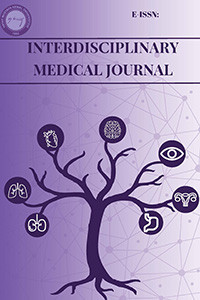Göğüs hastalıkları kliniklerinde çalışan hemşirelerin noninvaziv mekanik ventilasyon bilgi düzeyi
NIMV bilgi düzeyi, hemşire, Göğüs hastalıkları hemşireliği
Noninvasive mechanical ventilation knowledge level of nurses working in chest diseases clinics
NIMV knowledge level, nurse, Chest diseases nursing,
___
- Saltürk C, Kargın F, Berk Takır H, Adıgüzel N, Güngör G, Balcı M, et al. Yoğun bakım ünitesinde gece noninvaziv mekanik ventilasyon maske uygulama sıklığı. Göztepe Tıp Dergisi 2012; 27: 90-3. https://doi:10.5222/J.GOZTEPETRH.2012.090
- Carron M, Freo U, BaHammam AS, Dellweg D, Guarracino F, Cosentini R, et al. Complications of non-invasive ventilation techniques: a comprehensive qualitative review of randomized trials. Br J Anaesth 2013; 110: 896-914. https://doi.org/10.1093/bja/aet070
- Hill NS. Where should noninvasive ventilation be delivered? Respir Care. 2009 Jan;54(1):62-70. PMID: 19111107.
- Browning J, Atwood B, Gray A. Use of non-invasive ventilation in UK emergency departments. Emerg Med J 2006; 23:920-1. https://doi.org/10.1136/emj.2006.038950
- Merve Tarhan, Özcan Hançer, Fulya Polat, Songül Akbaş Gökduman, Levent Dalar. Noninvasive Mechanical Ventilation Knowledge Level of the Nurses: A Questionnaire Survey in a Tertiary Care Training and Research Hospital. 2015;17(3):163-170. https://doi.org/10.5152/ejp.2015.14633
- Carlucci A, Delmastro M, Rubini F, Fracchia C, Nava S. Changes in the practice of non-invasive ventilation in treating COPD patients over 8 years. Intensive Care Med 2003; 29: 419-25. https://doi.org/10.1007/s00134-002-1574-1
- Elliott MW, Confalonieri M, Nava S. Where to perform noninvasive ventilation? Eur Respir J 2002; 19: 1159-6. https://doi.org/10.1183/09031936.02.00297202
- Oppersma E, Doorduin J, van der Heijden EH, van der Hoeven JG, Heunks LM. Noninvasive ventilation and the upper airway: should we pay more attention? Crit Care 2013; 17: 245. https://doi.org/10.1186/cc13141
- Plant PK, Owen JL, Elliott MW (2000) Early use of non-invasive ventilation for acute exacerbations of chronic obstructive pulmonary disease on general respiratory wards: a multicentre randomised controlled trial. Lancet 355:1931–1935. https://doi.org/10.1016/s0140-6736(00)02323-0
- Antonelli M, Conti G, Rocco M, Bufi M, De Blasi RA, Vivino G, Gasparetto A, Meduri GU (1998) A comparison of noninvasive positivepressure ventilation and conventional mechanical ventilation in patients with acute respiratory failure. N Engl J Med 339: 429–43. https://doi.org/10.1056/NEJM199808133390703
- Raurell-Torredà M, Argilaga-Molero E, Colomer-Plana M, Ródenas-Francisco A, Garcia-Olm M. Nurses' and physicians' knowledge and skills in non-invasive ventilation: Equipment and contextual influences. Enferm Intensiva. 2019 Jan-Mar;30(1):21-32. English, Spanish. https://doi.org/10.1016/j.enfi.2018.04.006.
- Confalonieri M, Gazzaniga P, Gandola L, AiolfiS, Della Porta R, Frisinghelli A, Bellone A. He-modynamic response during initiation of non-invasive positive pressure ventilation in COPDpatients with acute ventilatory failure. RespirMed. 1998;92(2):331-7. https://doi.org/10.1016/s0954-6111(98)90117-2
- Gay PC. Complications of noninvasive ventilation in acute care. Respir Care. 2009 Feb;54(2):246-57; discussion 257-8. PMID: 19173756.
- Mas A, Masip J. Noninvasive ventilation in acute respiratory failure. Int J Chron Obstruct Pulmon Dis 2014; 9: 837-52. https://doi.org/10.2147/COPD.S42664
- Nava S. Interfaces for NPPV. In: Brochard L, Hill N, eds. Noninvasive positive pressure ventilation in acute respiratory failure. Paris, France, International Concencus Conferance in Intens Care Med 2000:2.
- Saatci E, Miller DM, Stell IM, Lee KC, Moxham J. Dynamic dead space in face masks used with noninvasive ventilators: a lung model study. Eur Respir J 2004; 23: 129-35. https://doi.org/10.1183/09031936.03.00039503
- Çelikel T. Noninvazif mekanik ventilasyon. Yoğun Bakım Dergisi 2002;2(4): 225-45
- García-Maribona J, González M, Blanco JM, Monroyt JC. Caring for noninvasive ventilation patients. In: A. Medina, M. Pons, F. Martinón Torres, editors. Non-invasive ventilation in Pediatrics. 2nd ed. 2004; pp. 65-74.
- Turan G, Şengöz İnan A, Akgün N, Taşçıoğlu J, Göktaş P. The effective usage time of the humidifier/Bactriel filters in the mechanical ventilator circuits. J Clin Anal Med 2011; 2: 46-8. https://doi.org/10.4328/JCAM.353
- Yayın Aralığı: Yılda 3 Sayı
- Başlangıç: 2023
- Yayıncı: Hatay Mustafa Kemal Üniversitesi Tıp Fakültesi Dekanlığı
Yenidoğan Yoğun Bakımda İzlenen Pnömotorakslı Olguların Değerlendirilmesi
Nuriye MELEKOĞLU, Muhammed Selçuk SİNANOĞLU, Erhan BERK
COVID-19 pandemisi döneminde onkolojik ve acil cerrahi vakalarının yönetimi
M. Burak DAL, Mustafa UĞUR, Mehmet Esat DUYMUŞ, Muhyittin TEMİZ
Seher KURTUL, Funda KAYA AK, Meral TÜRK
Kolon kanserini taklit eden kolon lipomu: Olgu sunumu
İlke Evrim SEÇİNTİ, Betül ŞİMŞEK, Salih ŞİMŞEK, Süleyman UYSAL, Ozan ÖZTÜRK
Sol meme radyoterapisinde brakial pleksus, karotis arter ve tiroid dozlarının değerlendirilmesi
Gökçen İNAN, Osman Vefa GÜL, Hamit BAŞARAN
Gülsüm KAYA, Şeyma TRABZON, Selma ALTINDİŞ, Ruveyda ALACAHAN
Neslihan GÜNEY, İclal GÜRSES, Ebru SERİNSÖZ LİNKE, Didar GÜRSOY, Enver ÜÇBİLEK, Tahsin ÇOLAK
Nihan KATAYIFÇI, İrem HÜZMELİ, Nursel DİKMEN, Bircan YUCEKAYA
